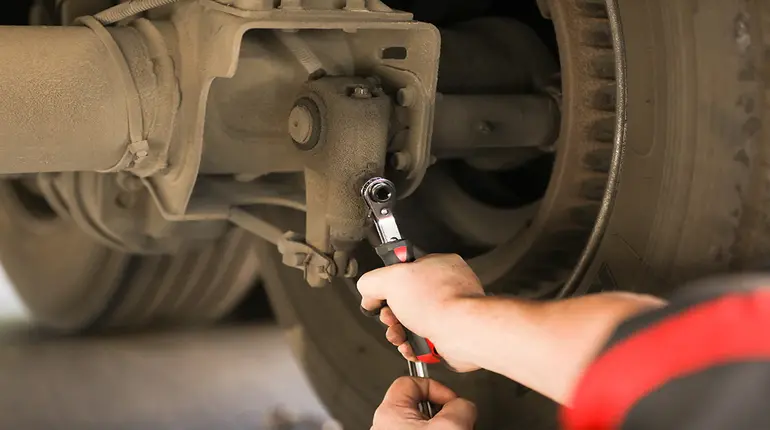While a slack adjuster might not be a term that rolls off the tongue in everyday conversations, the role it plays is nothing short of paramount. It ensures safety on the road. But if the part fails to maneuver correctly, you can face potential risks on the road.
So here is a deep resource about the common causes that lead to slack adjuster failure. Understanding them helps you to drive safely on the open road.
What is a slack adjuster?
A slack adjuster is a basic component of a vehicle’s braking system. It serves as a linchpin for brake performance.
This mechanical device is an integral part of an air brake system that is commonly found in commercial trucks, buses, and other heavy vehicles. Its primary function is to regulate and control the travel distance, or “slack,” between the brake shoes and the brake drum.
In an air brake system, when the brake pedal is pressed, compressed air is sent to the brake chambers located at each wheel. The brake chamber converts this compressed air into mechanical force. Pushing the brake shoes against the brake drum creates friction and stops the vehicle.
Now, this is where the slack adjuster steps in. It acts as the bridge between the brake chamber and the brake shoes. When you push the brake, the slack adjuster extends or contracts. It ensures that the brake shoes maintain the optimal distance from the brake drum.
This distance is critical because if it’s too large (too much slack), the brakes won’t engage effectively, resulting in reduced braking performance. Conversely, if it’s too small (insufficient slack), it can cause the brakes to drag and overheat, potentially leading to brake failure.
What causes a slack adjuster to fail?
The saying “an ounce of prevention is worth a pound of cure” couldn’t be truer when it comes to slack adjusters and their maintenance. Here are the common causes of a slack adjuster to fail.
Lack of regular maintenance
Just like any other part of a vehicle, slack adjusters require regular attention to ensure they are in proper working condition. It is ideally conducted during scheduled maintenance checks. It is essential to identify issues before they escalate into serious problems.
Checking the slack adjuster is necessary for proper maintenance and involves inspecting, cleaning, lubricating, and adjusting. This not only extends its lifespan but also contributes to the overall safety of the vehicle.
Corrosion and rust
Corrosion and rust are a silent and persistent enemy of many vehicle components like the slack adjuster.
Various environmental conditions like rain, snow, road salt, and even moisture from the air can all contribute to the corrosion of metal components. Since slack adjuster is a metal component, it gets rust when come into contact with moisture and oxygen.
Corrosion weakens the structural integrity of the slack adjuster. Over time, the affected components become brittle or develop cracks, increasing the risk of mechanical failure.
Slack adjusters rely on smooth, unhindered movement to adjust the clearance between brake shoes and drums. Corrosion can impede this movement, preventing the slack adjuster from functioning correctly.
Corrosion can alter the dimensions and tolerances within the slack adjuster, making it challenging to maintain the optimal clearance. This can result in uneven brake wear and diminished braking efficiency.
Over adjustment or under adjustment
Improper adjustment settings of a slack adjuster can exert undue stress on this critical component of the braking system.
When a slack adjuster is over adjusted, it means that it is set to maintain less clearance between the brake shoes and drum than necessary. This results in the brakes being in constant contact with the drum, even when not in use.
It leads to constant friction between the brake component and cause them to wear out rapidly. It also generates excessive heat, potentially leading to brake fade, reduced stopping power, and even brake component failure.
Conversely, under adjustment occurs when the slack adjuster maintains too much clearance between the brake shoes and drum, making it necessary for the brake chamber to exert more force to engage the brakes effectively.
Under adjustment can result in delayed brake engagement, reducing the effectiveness of the braking system. This can lead to longer stopping distances and increased risk of accidents.
In situations requiring heavy braking, such as descending steep slopes, under adjusted brakes can overheat quickly due to prolonged friction, potentially causing brake fade and loss of control.
Wear and tear
Constant usage is an inherent aspect of a vehicle’s lifespan, and it takes a toll on various components, including slack adjusters.
As a vehicle is driven, the slack adjuster is subjected to the repetitive stress of braking and adjusting the brake clearance. This constant cycling can cause components like pivot points, fasteners, and linkages within the slack adjuster to gradually wear out.
Additionally, exposure to road debris and contaminants can accelerate this wear and tear process. It affects various components within the slack adjuster, including pivot pins, bushings, and the adjusting mechanism. Over time, these components may develop play, become loose, or experience increased friction, hindering the slack adjuster’s ability to function optimally.
Manufacturing defects
While less common, manufacturing defects can be a source of slack adjuster failure, and their consequences can be significant. Manufacturing defects can manifest in various ways, including incorrect dimensions, subpar materials, or faulty assembly.
How to tell a slack adjuster is bad?
Recognizing the signs of a failing slack adjuster is crucial for maintaining vehicle safety and preventing potential brake system issues. Here, we describe the symptoms:
- Spongy Brake Pedal: If you notice that the brake pedal feels soft or requires more effort to engage, it could be a sign of a failing slack adjuster. A properly functioning slack adjuster ensures prompt and firm brake engagement.
- Uneven Brake Wear: Check the wear patterns on your brake shoes. If you observe uneven wear, with some shoes significantly more worn than others, it may indicate that the slack adjuster is not maintaining consistent clearance.
- Reduced Stopping Power: If your vehicle takes longer to come to a stop than usual or exhibits reduced braking efficiency, it’s a clear sign of a problem in the braking system, which could be linked to the slack adjuster.
- Brake Dragging: If you hear squealing or notice excessive heat coming from the brakes after use, it could signify that the slack adjuster is not releasing the brakes properly, leading to dragging.
- Audible Clicking or Ratcheting Sounds: Slack adjusters are designed to make a clicking or ratcheting sound when they adjust. If this sound becomes continuous or irregular, it may indicate a malfunction.
- Visual Inspection: Physically inspect the slack adjuster for signs of damage, such as corrosion, rust, loose parts, or visible wear.
How to prevent a slack adjuster failure?
Preventing slack adjuster failure is crucial for maintaining the safety and performance of your vehicle.
Regular inspections:
Conduct routine inspections of your slack adjuster as part of your vehicle’s maintenance schedule. Use a checklist to ensure a thorough examination, like checking for signs of wear, corrosion, proper movement, and alignment.
Proper lubrication:
You should follow the manufacturer’s recommendations for lubrication intervals and types of lubricants. Keep pivot points and moving components well-lubricated to reduce friction and prevent premature wear.
Correct adjustment:
Maintain the proper adjustment settings for your slack adjuster. Consult your vehicle’s manual or manufacturer guidelines for adjustment procedures and specifications. Regularly check and adjust the slack adjuster as needed to ensure it maintains the correct clearance between the brake shoes and drum.
Quality replacement parts:
When replacing slack adjusters or their components, choose high-quality, reputable brands or original equipment manufacturer (OEM) parts. Ensure compatibility with your vehicle’s make and model to avoid compatibility issues.
Environmental protection:
Park your vehicle in covered or sheltered areas when possible to reduce exposure to harsh weather conditions. Wash and clean the undercarriage of your vehicle regularly to remove road salt and contaminants that can contribute to corrosion.
Conclusion
The importance of addressing slack adjuster issues cannot be overstated. Failure to do so can lead to compromised brake performance, safety risks, and increased costs.
In terms of vehicle safety, it’s often the unsung heroes like slack adjusters that ensure our well-being on the road. You need to take proactive steps to maintain them so that we can contribute to safer, more efficient, and cost-effective journeys.






